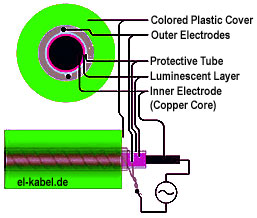Q1:What is Electroluminescence (EL)? |
-
Electroluminescence, used for EL-wires, describes a category of luminescence were electrical energy is converted to light inside a solid dielectric
without the need of a pn-junction and thus without generation of heat.
This draws a clear technical distinction to LED's and is the reason for its second name cool-light.
Accelerated by an AC electrical field the excited electrons cause the emission of a soft light evenly throughout the electroluminescent (EL) material.
Similar to a capacitor the AC-voltage is applied on an outer and inner metal-electrode with the EL-material in between as the dielectric. The typical frequency is around 1.5kHz the voltage about 100 Vrms.
|
Q2:What is inside the EL-Wire? |
-

-
-
Unlike light-panels and OLED's the electroluminescence wires are constructed in circular symmetry, so the light shines evenly over the full 360° of the circumflex and on the full length of the wire.
The inner electrode is a solid copper-wire that also provides the mechanical strength.
The outer electrode is made by a pair of thin wires that provide enough space between them so that the glowing dielectric stays fully visible.
Because the conductivity of the electrodes is high and the current-flow through the electroluminescent material is low. EL-wire has the same brightness up to a few hundred meters,
even so the electrodes are connected to the AC-source on one end of the wire only.
|
Q3:Are EL-Wires dimmable? |
-
Yes, Electroluminescence-wires are dimmable by controlling the DC supply-voltage of the inverter.
For all inverters with an external power-supply the EL-voltage and hence the brightness will follow the input voltage.
Operation starts at around 50% of the nominal voltage (6VDC) and reach its maximum brightness at 100% (12VDC).
|
Q4:The Inverter is noisy |
-
Electroluminescence is driven by an AC-voltage with a frequency between 1 and 2kHz.
Even we do have the lowest noise-level on the market a vibration of the transformer-windings inside the inverter can not be avoided completly. Unfortunately the human ear is quite sensitive to the resulting whistling sound.
There are two countermeasures:
1) Cover the Inverter with Acrylic from the DIY-store (Silicone will have ne effect)
2) For critical applications at home hide the inverter in the neighboring room or inside the wall. The twin-cable between inverter and EL-wire can be several meters long.
|
Q5:How to fix the EL-wire on a surface? |
-
EL-wire can be glued, sewed or fit in a groove.
While the wire is flexible and robust, avoid permanent stretching above 1kg, areas of great pressure or bending that will cause a deforming of the wire.
For more mounting hints see here:
Soldering/DIY >>.
|
Q6:What are the electrial Properties? |
-
EL-wires are driven by a sinus shaped voltage of about 100 Vrms amplitude. The frequency should be about 1.5kHz.
With these parameters EL-wire consumes approximately 10mA/Meter and the maximum of lifetime and brightness is achieved.
Our inverters with battery or external DC-supply provide this optimal EL-voltage.
|
Q7:Installations without power-cable? |
-
A combination of two car batteries in series and a DC-DC converter will supply even a huge outdoor illumination with neonstrings.
|
Q8:What is needed to light up EL-Wires? |
-
(1) The EL-wire, (2) an inverter or transformer,
(3) batteries or a power-supply to run from the 230VAC plug.
Additionally you would need soldering material, shrinkage tube and superglue.
(See the hints at
Connection/DIY ).
|
Q9:Shipment costs / delivery times? |
|
|
 el-kabel.de >>
light-by-wire.com >>
el-kabel.de >>
light-by-wire.com >>
 el-kabel.de >>
light-by-wire.com >>
el-kabel.de >>
light-by-wire.com >>